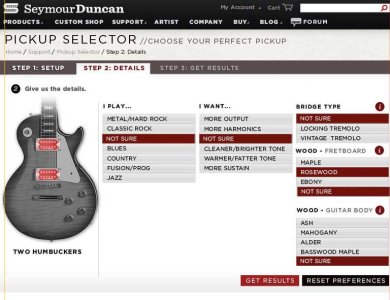IMENATOR
Well-known member
Re: Seymour Duncan mV Data
I think the mVolts readings should be delivered with a comprehensive explanation of what they mean and what they don't mean. I think this is table is great to choose a pickups to balance in volume when playing clean but in my humble and short experience a louder pickup may not translate to thicker or heavier sound when playing thru overdrive/distrotion, maybe that is what the EQ should help to?. Anyways I think this is a great thing you are doing, just be carefull to set the proper expectation on how to use it and it will be great.
Edit: I know people out there uses like an informa vocabulary for pickups and their characteristics. Maybe the more experienced people of the forum can put their own rating on growl, bite and stuff like that. After all we always go to the forum and ask for opinions on which pickup one has more bite, growl etc and I have seen a lot of threads where suggestions from the users lead to good results, as long as the asking person really knows what he wants of course. This may sound revolutionary but not so much if you think about it.
I think the mVolts readings should be delivered with a comprehensive explanation of what they mean and what they don't mean. I think this is table is great to choose a pickups to balance in volume when playing clean but in my humble and short experience a louder pickup may not translate to thicker or heavier sound when playing thru overdrive/distrotion, maybe that is what the EQ should help to?. Anyways I think this is a great thing you are doing, just be carefull to set the proper expectation on how to use it and it will be great.
Edit: I know people out there uses like an informa vocabulary for pickups and their characteristics. Maybe the more experienced people of the forum can put their own rating on growl, bite and stuff like that. After all we always go to the forum and ask for opinions on which pickup one has more bite, growl etc and I have seen a lot of threads where suggestions from the users lead to good results, as long as the asking person really knows what he wants of course. This may sound revolutionary but not so much if you think about it.
Last edited:


